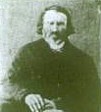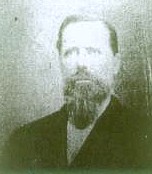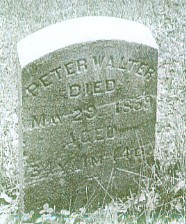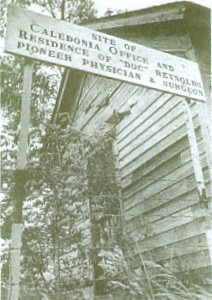|
HISTORY of CALEDONIA, IOWA

Caledonia, now a ghost town, is located in the northwest quarter of Section 10, Lott's Creek Township [T67N, R29W] in
Ringgold County, Iowa, approximately three miles north of the Iowa/Missouri state line, and six miles south of Mt. Ayr.
In the year of 1855, a large group of pioneers, the WALTER
family along with their kinfolk comprising of the STUCK and
SWIGART families, arrived in Iowa. They had traveled by ox wagons from Swan Creek, Ohio. Following the Dragoon Trace, the
pioneers arrived at Lotts Creek located along the east fork of the Grand River. The pioneers included descendants of John WALTER,
a widower - Fanny (WALTER) and Isaac SWIGART, Catherine (WALTER) and Ed STUCK, John Jr. and Susan (SWIGART) WALTER, and
Peter WALTER who was unmarried. Also in the group were John's brother Abraham WALTER and his wife Martha (FREED) and their
children, John's brother George WALTER and his wife Catherine (SWIGART), John's sister Sarah and her husband David BALES, and
John's brother Martin WALTER. Martin WALTER left the group in eastern Iowa where he settled. Sarah (WALTER) and David
BALES journeyed on to Gentry County, Missouri.
 When the WALTER and affiliated kin arrived in Lotts Creek, Ringgold City was
the only settlement in that portion of Ringgold County. Ringgold City consisted of a store and a trading post. Seeing a need,
Peter WALTER decided to found a town in the center of where the family had settled. Abraham WALTER, pictured at right, donated the land
and the town was founded around the year 1855 with the post office opening in 1856. Peter would serve as the town's first
postmaster.
When the WALTER and affiliated kin arrived in Lotts Creek, Ringgold City was
the only settlement in that portion of Ringgold County. Ringgold City consisted of a store and a trading post. Seeing a need,
Peter WALTER decided to found a town in the center of where the family had settled. Abraham WALTER, pictured at right, donated the land
and the town was founded around the year 1855 with the post office opening in 1856. Peter would serve as the town's first
postmaster.
 Around this time, Reverend Peter ANDREWS, pictured at right, a widower from Nova Scotia, settled in Lotts Creek with
his brother-in-law William CAMPBELL and Peter MOFFITT. Rev. ANDREWS was a Baptist minister and had obtained a better education
than the other settlers in the area. He was given the distinction of naming the newly founded town. His choice was "Caledonia"
which was taken from Sir Walter SCOTT's "Lady of the Lake."
Around this time, Reverend Peter ANDREWS, pictured at right, a widower from Nova Scotia, settled in Lotts Creek with
his brother-in-law William CAMPBELL and Peter MOFFITT. Rev. ANDREWS was a Baptist minister and had obtained a better education
than the other settlers in the area. He was given the distinction of naming the newly founded town. His choice was "Caledonia"
which was taken from Sir Walter SCOTT's "Lady of the Lake."
Another version is that the name "Caledonia" is a Latin name given by the Roman Empire to a northern
area of Great Britain.
Two more of John WALTER's daughters, Elizabeth and Anna,
arrived in a one-horse carriage from Swan Creek, Ohio. Elizabeth would later marry the widower Rev. Peter ANDREWS.
from Pearle V. (Bramon) Foland's scrapbook
 Unfortunately, Peter WALTER died in 1859 of tuberculosis and was interred at the new
cemetery located west of Caledonia. He did not live long enough to see his town grow rapidly and thrive.
Unfortunately, Peter WALTER died in 1859 of tuberculosis and was interred at the new
cemetery located west of Caledonia. He did not live long enough to see his town grow rapidly and thrive.
The Caledonia Methodist Church was built in 1872. Also in 1872, A. FOSTER owned and
operated the general store. His brother L. FOSTER ran a harness shop and hotel which was standing, but in poor condition
in the late 1970's. A. FOSTER was appointed as Caledonia's postmaster in February of 1882. FOSTER located the post office
in the rear of his general store, located on the west side of Main Street. He later relocated his store and post office
to the east side of Main Street, moving into what was once the broom shop.
The Odd Fellows Lodge #293 was established and re-chartered in February of 1893.
The 1894 Ringgold County Plat Book recorded 14 buildings along Main and Summit Streets. According to
the business directory of 1899, Caledonia had a broom shop, a Baptist Church, a Methodist Episcopal Church, FOSTER's
general store, FOSTER's harness shop, FOSTER's hotel, SMITH Brother's general store, the I.O.O.F. hall, a blacksmith,
three dressmakers' shops, a millinery store, a furniture store, a drug store, a doctor's office, and a saw mill located
west of town. There was a post office and 10 residences.
 Caledonia's doctors were Dr. REYNOLDS, Dr. I. THOMPSON, and Dr. JESSUP. Storekeepers included General S. MOON, Arl FOSTER, Homer FOSTER, John K. WHITE, Charles and
Maude BURCHETT, Les STRAIGHT, and Orval Van WINKLE.
Caledonia's doctors were Dr. REYNOLDS, Dr. I. THOMPSON, and Dr. JESSUP. Storekeepers included General S. MOON, Arl FOSTER, Homer FOSTER, John K. WHITE, Charles and
Maude BURCHETT, Les STRAIGHT, and Orval Van WINKLE.
According to local legend, Frank and Jesse JAMES and their gang hid out near Caledonia after robbing the Corydon
Bank in June of 1871.
Caledonia's post office closed on June 15th of 1908. A. FOSTER continued to operate his general store until he sold out to
John WHITE in 1915. Bonnie and Clyde, along with Clyde's
brother Buck BARROW and Blanche BARROW, stopped at Caldeonia for supplies and bandages when fleeing from Missouri. The
BARROW gang were involved in a shootout the following day, July 24, 1933, near Dexter, Iowa, where Buck was mortally
wounded and Blanche was apprehended. Bonnie and Clyde eluded capture.
Redding Herald
Redding, Ringgold County, Iowa
July 27, 1933
BARROW GANG AT CALEDONIA STORE

The BARROW bandits, three men and two women, two of whom were captured near Dexter Monday, camped for dinner a short
distance north of Caledonia Thursday of last week. They have left a trail of murder and robbery from Texas through Oklahoma,
Arkanss, Missouri and Iowa. Their latest battle before coming into Iowa was at North Platte, Missouri, when they shot their way
out of a tourist camp and escaped from a posse of a dozen officers who had demanded their surrender. Some of them were
severely wounded at North Platte. Last Thursday they drove through Caledonia, past the store a short distance, and one man
came back and bought a can of gasoline and carried it to the car. He also bought some bandages and groceries. They camped
for dinner a short distance north of Caledonia. After they had gone, a farmer living nearby noticed they had left a fire and
he went to investigate and he found they had attempted to burn some bloody clothing. he stomped the fire out and called the
sheriff, but no more was heard until they were captured at Dexter Monday. By their description it is said there is no doubt
but what they were the BARROW bunch. The property 1 1/4 miles north of Caledonia where the BARROW
gang stopped belonged to Frank MARSH. He was the one who called the sheriff. Frank's grandson John MAY recalled that
when the campers were later identified, there was quite a scare in the family when a stranger came to the house asking
for Frank. It wasn't known if the man was a member of the BARROW gang or not.
Walter PUTNEY said that Bonnie and Clyde had "borrowed" a can of gasoline from their farm, leaving a
$10 bill behind, which was a lot of money back then. During the Platte City, Missouri, shoot-out, Buck was wounded and the flying glass injured Blanche's
eye. Blanche and Buck were captured at Dexter. Buck died a few days later in a hospital at Perry, Iowa. Blanche
went to prison in Missouri. W. D. JONES also went to prison. Bonnie and Clyde met their fate on a rural Louisiana road.
The Story of the Barrow Gang can be found on Ringgold County's
History Page
about Bonnie and Clyde.
Lexington FOSTER'S Caledonia Hotel
In 1970, The Mount Ayr Record-News stated
that Caledonia had a population of 270 people at one time. An aerial photograph from 1966 reveals that the school, a
church, the hotel and a few homes and farm buildings were still standing at Caledonia.
The last building remaining in Caledonia, 2007. This building was the office of Dr. A. W. REYNOLDS and later burned down.
"The Caledonia Store Site: The first store here was owned and operated by General E. MOORE (illegible) was fleeing from the law. Stopped (illegible)."
All that remains of Caledonia is one house and some outbuildings. Signs mark the location of
what used to be in Caledonia. Caledonia photograph page
The Caledonia Cemetery is located approximately 1/2 a mile (maybe more) west of Caledonia's
town site. It is situated back in a pasture which cannot be seen from the road. There isn't a path to the cemetery.
We found it by following the tire tracks in the grass. Caledonia
Cemetery photograph page. While taking photographs at Caledonia, I stopped and visited with
Jay BOWEN. Jay told me that Mr. BURCHETT owned the Caledonia store when Bonnie and Clyde stopped for supplies. A short time
later, Mr. BURCHETT died and his wife sold the store since it was too much for her to handle with two small daughters.
They moved to Mount Ayr where they lived until Social Security became a reality in America. Mrs. BURCHETT obtained a
job with the Social Security Administration and moved with her daughters to Baltimore, Maryland. Her daughters still
reside in the Baltimore area. A diorama of Caledonia was built by former resident Holland FOSTER from old plat maps and early photographs. It is
housed in the Ringgold County Pioneer Center in Ellston.
Cemetery Gate, Caledonia Cemetery
Photograph contributed by
Mrs. Andy (Joyce) JOHNSTON
Pipe Plant by Holland FOSTER, 1933-34
Smithsonian American Art Museum, Washington, D. C.
Artist Holland FOSTER was born in Caledonia, Iowa, March 15, 1906, the son of Homer A. FOSTER (1870-1946) and
Beatrice Cecil (HOLLAND) FOSTER (1872-1910). Holland married Dora Lucinda RANSOM (1907-1990). Holland
and Dora were the parents of five children: Norman Holland (1934-1999), Homer Ransom, Robert Harry,
Alexander Elliot, and Susan Jean FOSTER. Holland FOSTER died June 12, 1984, Palm Springs, California.

Mount Ayr Record News
Mount Ayr, Ringgold County, Iowa
Thursday, May 19, 2011
Snapshots of History
By Mike Avitt
Thanks to Mabel SHIELDS for allowing me to scan this photograph of the Caledonia schoolhouse. The last year the school
was operating was 1958 and Evelyn WARRICK was the teacher. Her students included Dean and Beverly DEEMER, Barton and Joe
SHIELDS, Gary SHIELDS, Dean SCOTT, Derald and Gerald NOBLE, Jim SHAHA, and Jerry SHIELDS. Mabel began teaching here in
1942. She was my eighth grade reading teacher in 1970-71 at Mount Ayr. Caledonia was founded in 1955
by the WALTER, STUCK and SWIGART families who came to Ringgold county from Ohio the same year. It sits about eight
miles southeast of Mount Ayr and the name Caledonia is a romantic reference to Scotland. Peter WALTER is credited
with establishing Caledonia. He died in 1859 and is buried in the Caledonia Cemetery. Other settlers followed
and because Caledonia is located long the Dragoon Trace, it was believed that a railroad would be built through
the expanding community. But the rails did not come and Caledonia, like all non-railroad towns, became a farming
community with a handful of small businesses. The Ghost Town of Caledonia was published by Holland
FOSTER in 1978. Mr. FOSTER was born in Caledonia in 1906 and grew to have a successful career as an artist and art teacher.
In the book, he tells stories of his boyhood and speaks of his noted relatives such as Homer HOLLAND and
Homer FOSTER. Holland was especially proud of Caledonia's location in "The Nation," an area of southern Iowa
and northern Missouri that was frequented by bootleggers, bandits and other nefarious neer-do-wells. And, in
fact, there is proof of that assumption. It is documented that the BARROW Gang (Bonnie and Clyde) were in
Caledonia on July 20, 1933. After a bloody shootout with law enforcement officials in Platte City, Missouri the
previous evening, the gang was headed to a park near Redfield, Iowa, and stopped in Caledonia for gasoline, food
and medical supplies. The car was peppered with bullet holes so gang member W. D. JONES parked north of Caledonia
and walked to town for supplies. Buck BARROW had been mortally wounded in the shootout and his bloody clothes and bandages
were found at their campsite. The last time Caledonia received major recognition was probably September 19, 1982.
The Des Moines Sunday Register carried a "Picture Magazine" in the newspaper then and that edition featured
an article about Caledonia. Jim WALLING owned the Caledonia Methodist Church at that time. The last services
were held there in 1972 but Jim was using the church as a feed store. The church and Dr. REYNOLDS office were
the only two original buildings left in 1982. The church burned shortly after the article appeared but the
office of Doctor Allen Welch REYNOLDS would stand until the summer of 2007. Dr. REYNOLDS lived near Ringgold City
and traveled to his office in Caledonia until the 1930's when he retired. I had taken some photos of the office in
2005 and 2006, so I was familiar with the building. In 2007, I drove by and noticed the office had burned. I went
up the bank and kicked through the ashes to find electric wiring, which I knew was there but also found wool
insulation and metal roof edging. My experience with roofing suggested to me that the roof had been replaced since
Dr. REYNOLDS retired. And I was right. I related my story to Mabel SHIELDS and she said that a family lived in
the building, probably in the late 1940's. The family was that of Orville Van WINKLE, his wife Viola and their
daughter Violet. Mabel believed the Van WINKLE family later moved into the Caledonia general store which Orville
had purchased. So all that remains of Caledonia is the signs placed by the Ringgold County Historical Society
indicating locations, dates and general information. The cemetery also remains where founder Peter WALTER was
buried 156 years ago.

Mount Ayr Record News
Mount Ayr, Ringgold County, Iowa
Thursday, May 23, 2002
County Columns ~ Maloy
By Liz Lynch
Sunday afternoon Bob and Liz took flowers to Lotts Grove Cemetery south of the Watterson Quarry in Missouri. On the return
they turned east on the first Iowa road and drove past Liz's childhood home sites. It was sad because the area where the
house stood was so full of box elder trees you could not have walked through. A new trailer home and lawn had been set up
across the road in the timber clearing. They went on the 2.5 mile route she walked to Ringgold school and up the road north to
the Ringgold Cemetery. It and the one south of Watterson had been mowed up and looked great. They back tracked to the main
road and went east and north toward Caledonia. They saw the COULSON brother's beautiful herd of Charolais cattle. These
were on the pasture land where Ada ROGERS grew up. Part of the road traveled is on the Dragoon Trace.
Transcription by Sharon R. Becker
Mount Ayr Record-News
Mount Ayr, Ringgold County, Iowa
Thursday, March 23, 2017, Page 9
By Mike Avitt This is the last picture I took of the last original building at Caledonia. The owner burned it down about June 2007. As most of you know, Caledonia was a pit stop for the Barrow Gang (Bonnie and Clyde) as they robbed and murdered their way through the mid-west from 1932 to 1934. The gang, Clyde Barrow, his girlfriend Bonnie Parker, Clyde's brother Marvin "Buck" Barrow and his wife Blanche, and getaway driver W. D. Jones, stopped at Caldeonia on the morning of July 20, 1933 for gasoline, food, and medical supplies. The Barrow Gang was involved in a shootout about nine hours earlier at Platte City, Missouri and both Marvin and Blanche were severely wounded. Marvin would later die of his injuries. The gang parked their car at the Frank Marsh property, about one quarter mile north of Caledonia, and sent W. D. Jones on foot to the general store for the items they needed. Of course, the gang couldn't park where they would be seen because of the bullet holes, broken glass, and blood-soaked occupants. On the other hand, Mr. Jones making four trips to the store with a gas can was also suspicious. Marguerite Burchett Hecker wrote an eye-witness account of the event and I'll share some of that with you. Marguerite was eight years old at the time and her mother, Maud Burchett, owned the store. Marguerite had gone to the store that morning to visit with Esta Booth, who, along with her husband, Theodore, operated the business. As Marguerite was leaving, she noticed a customer (W. D. Jones) at the cookie case. Marguerite notified Esta of a customer and walked home. Marguerite later learned the Barrow Gang had visited her mother's store and rested briefly at the Frank Marsh property. After the gang left, empty bottles and remnants of lunch were found at their parking spot. The gang also attempted to burn bloody clothing and bandages. This event put quite a scare into the Caledonia community. The Barrow Gang was engaged in another shootout on July 24 or 25 at Dexfield Park near Redfield, Iowa. Marvin and Blanche were captured but Bonnie, Clyde, and W. D. Jones escaped. Marvin died at a Perry, Iowa hospital on July 29, 1933. Photograph courtesy of Mount Ayr Record-News
Transcription by Sharon R. Becker.


|